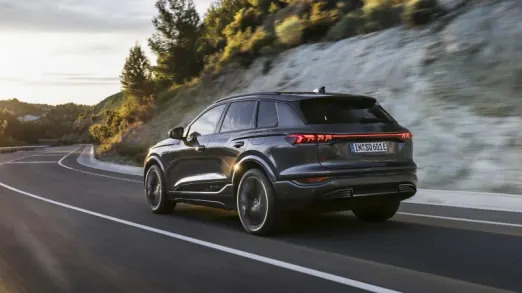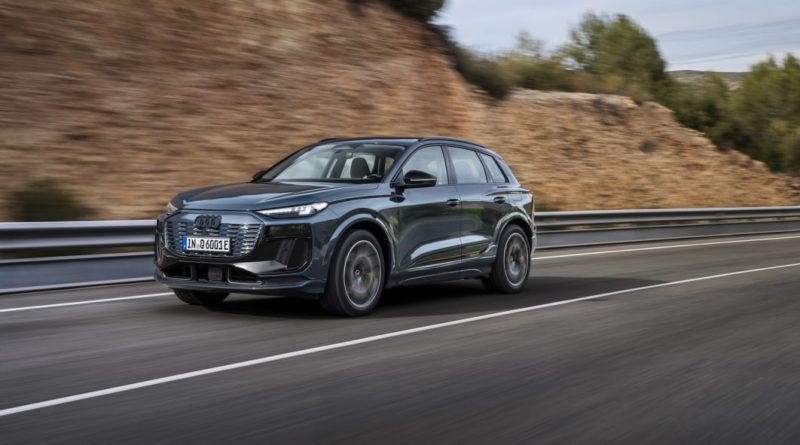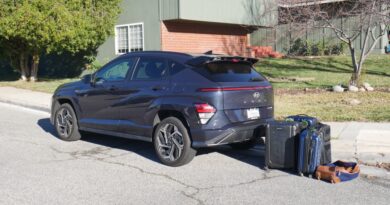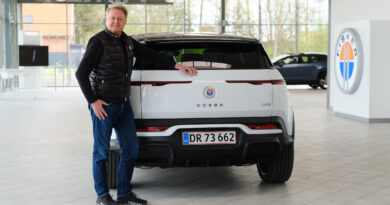Audi Q6 E-Tron Tech Deep Dive: Details about the electric Macan’s Audi sibling
Last summer, we had a brief chance to drive the new Audi Q6 e-tron in the Faroe Islands. It was a good tease of what to expect, though details and technological developments were somewhat scarce. After attending a deep dive into these aspects in Munich, it’s clear this latest EV from Audi is a solid all-electric SUV, though it doesn’t really break much new ground. Instead, it increases efficiencies throughout the drivetrain while adding some notable tech improvements.
First and foremost, the Q6 e-tron is the first Audi vehicle to ride on the new PPE platform (for Premium Platform Electric) that is shared with the all-electric Porsche Macan. Unlike some of the previous Audi EVs, it will largely be produced in-house as compared to the Porsche-sourced e-tron GT and VW-sourced Q4 e-tron.
The lithium-ion battery pack has a capacity of 100 kWh (94.9 kWh is usable), though other markets will also get a smaller 83 kWh capacity battery. The physical difference between the two comes down to a 12-module pack and 10 modules for the 83-kWh battery. Those modules are pulled from the center sections of the same pack to maintain a consistent weight distribution. This modularity allows Audi to produce them on the same assembly line, saving money as a result of this flexibility.
Initial models in the U.S. will have two electric motors that power the front and rear axles. A single-motor rear-wheel-drive variant will likely follow the Quattro all-wheel-drive to market — possibly in the first model year. Efficiencies also allow for cost savings as the motors vary in stator length, rather than diameter, and greatly simplify production. A single-gear transmission mated to the rear motor uses a dry-sump oil system, which reduces friction losses. Combined power output is 422 horsepower (456 hp in launch mode), which is potent enough to accelerate the Q6 e-tron Quattro to 60 mph in 5.0 seconds, according to Audi. Other markets have a slightly reduced output of 382 hp, so yay America! The SQ6, pictured below, increases output to 483 hp (510 hp in launch mode) and chops acceleration time down to 4.2 seconds.


The rear motor is the first to activate when accelerating from a stop, with the front motor contributing additional power shortly thereafter. When lifting off the accelerator, brake regeneration is also a two-step process, with the rear motor switching over first. When more aggressive braking is required, the front brake pads activate first for maximum stopping power. In most cases, 95 percent of braking can be accomplished without ever using the physical brake pads, relying greatly on regeneration and further improving efficiency. For the first time in Audi’s EV lineup, the Q6 e-tron is capable of one-pedal driving.
It sounds fairly complicated, but in practice, you’d never know what was going on behind the scenes, since these actions feel seamless from behind the wheel. The one-pedal mode isn’t as aggressive as other EVs so you’ll either have to begin deceleration earlier or tap the brake pedal in the last few feet. In our brief drive on an autocross course, handling is more capable than most drivers will need, with some noticeable body roll when cornering. The SQ6 e-tron will be the pick for those who prefer a sportier ride.
Getting back to efficiencies, keeping components cool is another contributor. The motors are kept from overheating with circulating fluid, allowing for fewer rare-earth elements and helping to keep costs lower. The battery employs complex plumbing that pushes coolant though the floor of the pack, ensuring optimal operating temperatures for improved range and charging. It also results in a longer battery life. Audi estimates the Q6 e-tron Quattro will return more than 300 miles of range on a single charge, which should beat the Q4 e-tron’s 265-mile estimate and meet or beat the Q8 e-tron’s 300-mile rating. Estimates for the SQ6 are not yet available.
Speaking of charging, the Q6 e-tron is capable of DC fast-charging at rates up to 270 kW, which should get the battery from 10% to 80% in 21 minutes. If you’re on a 400-volt charger, you can take advantage of bank charging, where the 800-volt battery is split into two 400-volt batteries that can charge in parallel. On a typical AC home charger, the e-tron has a maximum rate of 9.6 kW. At least for the first model year, the Q6 will come with a common CCS port on each side of the vehicle. The DC fast-charge receptacle is only on the driver’s side, though. There are plans to switch to the NACS Tesla-type charge ports by 2026 at the earliest. An adapter will be available to owners with the CCS ports so they can take advantage of the NACS infrastructure at a later date.
As stated at the top, the 2025 Audi Q6 e-tron doesn’t rewrite the EV book with any huge innovations. Instead, it makes steady progress with a wide variety of smaller improvements throughout the drivetrain that add up to a larger cumulative upgrade. Efficiency is definitely the name of the game here, both in terms of range and price, though official U.S. pricing hasn’t been announced yet. In Europe, the Q6 e-tron Quattro will start at 74,700 Euros while the SQ6 e-tron will sticker at 93,800 Euros when they go on sale this summer. They’ll make their way stateside at the end of 2024.




